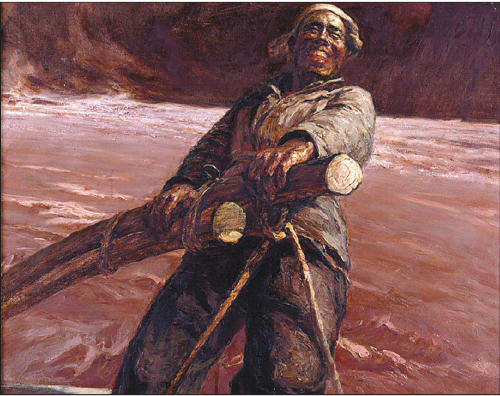
CHINA DAILY
The Storm Is Coming, oil on canvas by Zhong Han.
At age 84, Zhong Han describes himself as an "immature elderly painter", and that he is only "a tree in the forest that keeps absorbing nutrition from the earth".
Zhong's modesty and persistence in chasing perfection explain why he has just held a solo exhibition, celebrating his six-decade love of oil painting.
A professor with the Central Academy of Fine Arts, Zhong is displaying nearly 300 works at his retrospective, titled Earth and Humanity, at the National Art Museum of China.
A highlight of the exhibition is the juxtaposition of two large paintings with the same title, Along the Yanhe River.
Zhong painted the original in 1963, in which he portrayed Mao Zedong walking with a farmer along the river in Yan'an, the "cradle of China's communist revolution" in Shaanxi province.
A golden rule at that time was to show the late leader's brilliance by painting him front on or his side profile. Zhong made a brave breakthrough by painting Mao's back.
"The innovative approach displays a confident and resolute leader, as well as his earnest, unpretentious and approachable side," comments Fan Di'an, director of the National Art Museum of China.
The painting was highly acclaimed and widely covered by media. But it was unfairly treated during the "cultural revolution" (1966-76), when the Red Guards violently stamped on it.
Zhong thought the painting was totally destroyed, and he recreated a smaller version in 1999.
Years later, the original painting was rediscovered in a basement at CAFA, roughly wrapped in straw ropes.
"The work of 1999 shows my improvements in handling oil on canvas. But the original one fully reveals the pure persistence of a young painter of the 1960s," he says.
Zhong was enrolled at the architecture department of Tsinghua University in 1946. He joined the fine arts society on campus. He later began systematic art disciplines at the Huabei University (the current Renmin University).
Zhong produced the original Along the Yanhe River as a graduation work when he attended CAFA's oil painting research class. The class, taught by Chinese professors, enjoys equal reputation with another class taught by former Soviet Union oil painter K. M. Maximov, for cultivating New China's first-generation oil painters in the 1950s.
Also on show are Zhong's works that were inspired by his research into the European interior paintings and his experimental creations that apply elements of Chinese calligraphy, fresco and rock painting.
"Zhong has been observing the artistic transformations since the reform and opening-up. He has made academic contributions to the contemporary art scene, and particularly, his explorations have prompted the development of Chinese oil painting," Fan says.
Xu Bing, vice-president of CAFA, says the exhibition gives an overall view of why Zhong is respected as an important scholar-type artist by the Chinese art community.
He explains that China's fine-arts education experienced bottlenecks in the 1980s and '90s, when the art traditions collided with the Western art after opening-up, and then encountered powerful commercial influences. Zhong demonstrated his persistence and professionalism, leading the academy to find its right position in changing times.
Xu says he is most impressed by Zhong's ability to create and his ultimate pursuit of perfection, even though under limited conditions-referring to the hardships China experienced.
"Ultimately, an artist should fulfill his duties by completing works in his studio and upgrading his artistic language," Xu says.
IF YOU GO
9 am-5 pm, until Dec 4.
National Art Museum of China, 1 Wusi Dajie Street, Dongcheng district, Beijing.
010-6400-1476.
We recommend:
